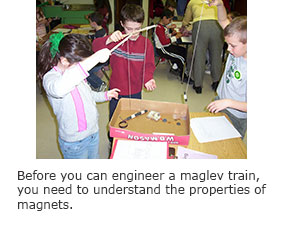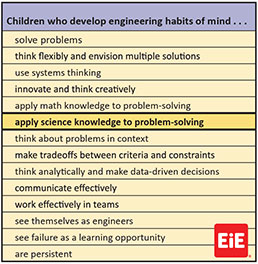All this month on the EiE blog, we’re using short videos that capture candid moments in elementary classrooms to look at how kids develop “engineering habits of mind” (ways of thinking that support lifelong learning). Today we look at the habit of “applying science knowledge to solve a problem through engineering."

Watch It Happen: Kids Apply Science to Engineering
We think the video presented here is exciting, because it captures the exact moment when science knowledge fuels an engineering breakthrough! As the scene opens, you see a team of 4th grade students working on the transportation engineering challenge from the EiE unit “The Attraction is Obvious: Designing Maglev Systems.”
They’re trying to make a maglev (magnetic levitation) system consisting of a palm-sized model train car that will travel along short length of “track” (a narrow cardboard box fitted with strips of magnets). To make the car hover above the track, the students have to use what they know about magnetic poles and the magnetic property of repulsion.
Using Science Knowledge is an Engineering Habit of Mind
But when the students test their system, it fails. Here’s where engineering habits of mind come in. These kids COULD just try moving their magnets around at random—experimenting with different positions and orientations until perhaps, by luck, they make the train float. Before they started working on their engineering design challenge, however, they had already explored the properties of magnets in science class. They learned that magnets have two poles, and that depending on the orientation of the poles, magnets may repel or attract each other.
Before they started working on their engineering design challenge, however, they had already explored the properties of magnets in science class. They learned that magnets have two poles, and that depending on the orientation of the poles, magnets may repel or attract each other.
Watch them call up this science knowledge! They examine the bar-shaped magnets, determine where the poles are, align the magnets so they repel . . . and send the little train zooming down the track.
Persistence Pays
It’s also worth noting how this team of young engineers took their initial failure in stride. They weren’t particularly upset; they just rolled up their sleeves and got back to work—embracing “improve” as an important step in the engineering design process. Besides applying their science knowledge to the engineering challenge, they demonstrated two other engineering habits of mind, “learning from failure” and “being persistent.”
From smartphones to the Hubble Space Telescope, our modern world is full of technologies that seem almost like magic. But they’re the direct result of the dynamic interplay between science and engineering: new science knowledge advances engineering, allowing for the creation of ever-more-sophisticated technologies, and sophisticated technologies enable researchers to make advances in science
We can’t know what the kids in this video will engineer when they grow up. But they’re in the habit of applying science knowledge, so we imagine great things.
To see more engineering fun with magnets, browse our Classroom Video collection.
Engineering is Elementary is a project of the National Center for Technological Literacy at the Museum of Science, Boston.








